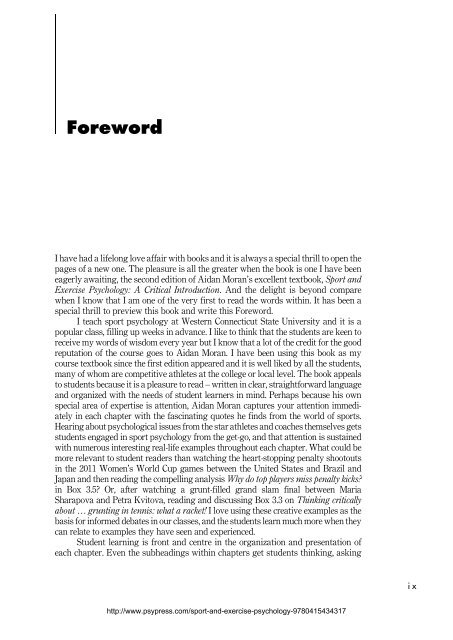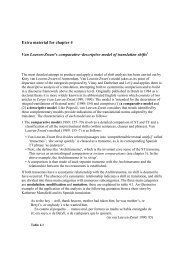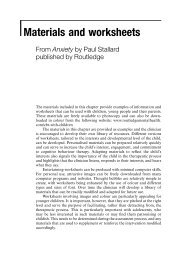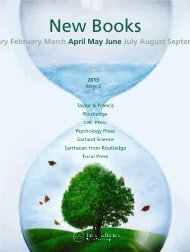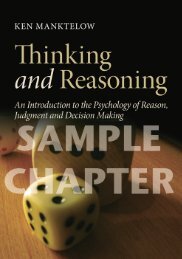Sport and Exercise Psychology: A Critical introduction ... - Routledge
Sport and Exercise Psychology: A Critical introduction ... - Routledge
Sport and Exercise Psychology: A Critical introduction ... - Routledge
You also want an ePaper? Increase the reach of your titles
YUMPU automatically turns print PDFs into web optimized ePapers that Google loves.
Foreword<br />
I have had a lifelong love affair with books <strong>and</strong> it is always a special thrill to open the<br />
pages of a new one. The pleasure is all the greater when the book is one I have been<br />
eagerly awaiting, the second edition of Aidan Moran’s excellent textbook, <strong>Sport</strong> <strong>and</strong><br />
<strong>Exercise</strong> <strong>Psychology</strong>: A <strong>Critical</strong> Introduction. And the delight is beyond compare<br />
when I know that I am one of the very first to read the words within. It has been a<br />
special thrill to preview this book <strong>and</strong> write this Foreword.<br />
I teach sport psychology at Western Connecticut State University <strong>and</strong> it is a<br />
popular class, filling up weeks in advance. I like to think that the students are keen to<br />
receive my words of wisdom every year but I know that a lot of the credit for the good<br />
reputation of the course goes to Aidan Moran. I have been using this book as my<br />
course textbook since the first edition appeared <strong>and</strong> it is well liked by all the students,<br />
many of whom are competitive athletes at the college or local level. The book appeals<br />
to students because it is a pleasure to read – written in clear, straightforward language<br />
<strong>and</strong> organized with the needs of student learners in mind. Perhaps because his own<br />
special area of expertise is attention, Aidan Moran captures your attention immediately<br />
in each chapter with the fascinating quotes he finds from the world of sports.<br />
Hearing about psychological issues from the star athletes <strong>and</strong> coaches themselves gets<br />
students engaged in sport psychology from the get-go, <strong>and</strong> that attention is sustained<br />
with numerous interesting real-life examples throughout each chapter. What could be<br />
more relevant to student readers than watching the heart-stopping penalty shootouts<br />
in the 2011 Women’s World Cup games between the United States <strong>and</strong> Brazil <strong>and</strong><br />
Japan <strong>and</strong> then reading the compelling analysis Why do top players miss penalty kicks?<br />
in Box 3.5? Or, after watching a grunt-filled gr<strong>and</strong> slam final between Maria<br />
Sharapova <strong>and</strong> Petra Kvitova, reading <strong>and</strong> discussing Box 3.3 on Thinking critically<br />
about … grunting in tennis: what a racket! I love using these creative examples as the<br />
basis for informed debates in our classes, <strong>and</strong> the students learn much more when they<br />
can relate to examples they have seen <strong>and</strong> experienced.<br />
Student learning is front <strong>and</strong> centre in the organization <strong>and</strong> presentation of<br />
each chapter. Even the subheadings within chapters get students thinking, asking<br />
http://www.psypress.com/sport-<strong>and</strong>-exercise-psychology-9780415434317<br />
ix


